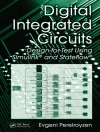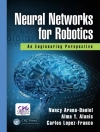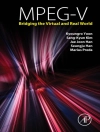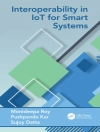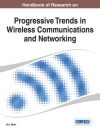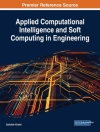We are currently witnessing an increase in telecommunications
norms and standards given the recent advances in this field. The
increasing number of normalized standards paves the way for an
increase in the range of services available for each consumer.
Moreover, the majority of available radio frequencies have already
been allocated. This explains the emergence of cognitive radio (CR)
– the sharing of the spectrum between a primary user and a
secondary user. In this book, we will present the state of the art
of the different techniques for spectrum access using cooperation
and competition to solve the problem of spectrum allocation and
ensure better management of radio resources in a radio cognitive
context. The different aspects of research explored up until now on
the applications of multi-agent systems (MAS) in the field of
cognitive radio are analyzed in this book. The first chapter begins
with an insight into wireless networks and mobiles, with special
focus on the IEEE 802.22 norm, which is a norm dedicated to CR.
Chapter 2 goes into detail about CR, which is a technical field at
the boundary between telecommunications and Artificial Intelligence
(AI). In Chapter 3, the concept of the ‘agent’ from AI
is expanded to MAS and associated applications. Finally, Chapter 4
establishes an overview of the use of AI techniques, in particular
MAS, for its allocation of radio resources and dynamic access to
the spectrum in CR.
Contents
1. Wireless and Mobile Networks.
2. Cognitive Radio.
3. Multi-agent Systems.
4. Dynamic Spectrum Access.
About the Authors
Badr Benmammar has been Associate Professor at UABT (University
Abou Bekr Belkaïd Tlemcen), Algeria since 2010 and was a
research fellow at CNRS La BRI Laboratory of the University of
Bordeaux 1 until 2007. He is currently carrying out research at the
Laboratory of Telecommunications of Tlemcen (LTT), UABT, Algeria.
His main research activities concern the cognitive radio network,
Quality of Service on mobile and wireless networks, end-to-end
signaling protocols and agent technology. His work on Quality of
Service has led to many publications in journals and conference
proceedings.
Asma Amraoui is currently a Ph D candidate; she is preparing a
doctoral thesis on a topic of research that explores the use of
artificial intelligence techniques in cognitive radio networks. She
is attached to the Laboratory of Telecommunications of Tlemcen
(LTT) in Algeria.
विषयसूची
ACRONYMS ix
INTRODUCTION xiii
CHAPTER 1. WIRELESS AND MOBILE NETWORKS 1
1.1. Introduction 1
1.2. Wireless networks 2
1.2.1. Definition 2
1.2.2. Function of a wireless network 3
1.2.2.1. Network with infrastructure 3
1.2.2.2. Network without infrastructure 4
1.2.3. Types of wireless networks 5
1.2.3.1. Wireless personal area network 6
1.2.3.2. Wireless local area network 6
1.2.3.3. Wireless metropolitan area network 6
1.2.3.4. Wireless wide area network 6
1.2.3.5. Wireless regional area network 6
1.2.4. Different types of existing wireless networks 7
1.2.4.1. Networks using infrared waves 7
1.2.4.2. Networks using radio waves 7
1.2.5. IEEE 802.22 standard 12
1.3. Mobile networks 12
1.3.1. Wireless and mobility 12
1.3.2. Mobility 13
1.3.3. Cellular architecture 13
1.3.4. Architecture of a cellular network 14
1.3.5. Telephony 15
1.3.6. Development of cellular systems 16
1.3.6.1. First generation 16
1.3.6.2. Second generation 16
1.3.6.3. Third generation 18
1.3.6.4. Fourth generation 18
1.4. Wi MAX mobile and 4G 19
1.5. Conclusion 20
CHAPTER 2. COGNITIVE RADIO 23
2.1. Introduction 23
2.2. Software radio 24
2.2.1. Software-defined radio 24
2.3. Introduction to cognitive radio 24
2.3.1. History 24
2.3.2. Definition 25
2.3.3. Relationship between cognitive radio and software-definedradio 26
2.3.4. Structure 27
2.3.5. Cognition cycle 29
2.3.6. Components of cognitive radio 31
2.3.7. Functions of cognitive radio 32
2.4. Languages of cognitive radio 35
2.5. Domains of cognitive radio applications 36
2.6. Conclusion 38
CHAPTER 3. MULTI-AGENT SYSTEMS 39
3.1. Introduction 39
3.2. Definition of an agent 39
3.2.1. The multidimensional characteristics of an agent 40
3.2.2. An agent’s concrete architecture 41
3.2.2.1. Architecture of logical agents 41
3.2.2.2. Reactive architecture 42
3.2.2.3. BDI architecture 42
3.2.2.4. Multilevel architecture 44
3.2.3. Model of an agent 45
3.3. Multi-agent systems 46
3.3.1. Communication between agents 46
3.3.1.1. Coordination protocols 46
3.3.1.2. Cooperation protocols 47
3.3.1.3. Negotiation 47
3.4. Application of MAS in telecommunications 48
3.4.1. MAS applications on the Web 48
3.4.2. Application of MAS in virtual private networks 49
3.4.3. Using MAS in the setting of third generation mobiles50
3.4.4. Application of MAS in network supervision andmanagement 50
3.5. Conclusion 50
CHAPTER 4. DYNAMIC SPECTRUM ACCESS 53
4.1. Introduction 53
4.2. Intelligent algorithms 54
4.2.1. Neural networks 55
4.2.2. Fuzzy logic 56
4.2.3. Genetic algorithms 57
4.3. Dynamic spectrum access 58
4.3.1. Spectrum access using the auction approach 58
4.3.2. Spectrum access using game theory 59
4.3.3. Spectrum access using Markov’s approach 60
4.3.4. Spectrum access using multi-agent systems 61
4.4. Conclusion 64
BIBLIOGRAPHY 67
FURTHER READING 75
INDEX
लेखक के बारे में
Badr BENMAMMAR is performing his research activities in Laboratory of Telecommunication of Tlemcen, UABT, Algeria.
Asma AMRAOUI is Currently preparing a doctoral thesis on a topic of research that explores the use of artificial intelligence techniques in the cognitive radio networks. She is attached to the LTT laboratory (Laboratory of Telecommunications of Tlemcen) in Algeria.


